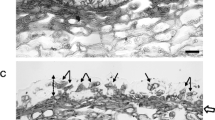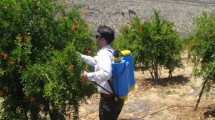Abstract
In mainland China, the most popular pineapple cultivar is ‘Comte de Paris’. Gibberellic acids have been widely applied to enhance fruit growth in various species. To evaluate the effect of gibberellic acid (GA3) on ‘Comte de Paris’ pineapple production and quality, pineapple fruits were sprayed with GA3 at concentrations of 5, 20, 50, or 100 mg l−1 at both 0 and 15 days after flowering (DAF). Fruits were sampled every 15 days from 0 to 60 DAF (maturation) for flow cytometric analysis and histological observation. The results showed that the treatments with the three highest concentrations of GA3 significantly increased fruit weight, and the most effective concentration was 50 mg l−1 GA3, which increased the flesh weight by 20.3% compared to the control. Although treatment with GA3 had little effect on the total soluble solids and fruit juice pH, it increased the vitamin C content. Although flow cytometric analysis showed that the 50 mg l−1 GA3 treatment had only a slight impact on the number of S phase cells, histological observations indicated that the increase of fruit volume and flesh weight under this GA3 treatment was not due to the increase of cell number but a result of the increase of cell area in the fruit flesh.



Similar content being viewed by others
References
Bartholomew DP, Paull RE, Rohrbach KG (2003) The pineapple: botany, production and uses. CABI Publishing, Wallingford
Cano-Medrano R, Darnell RL (1997) Cell number and cell size in parthenocarpic vs. pollinated blueberry (Vaccinium ashei). Fruits Ann Bot 80:419–425
Casanova L, Casanova R, Moret A, Agusti M (2009) The application of gibberellic acid increases berry size of ‘Emperatriz’ seedless grape. Span J Agric Res 7:919–927
Chang JC, Lin TS (2006) GA3 increases fruit weight in ‘Yu Her Pau’ litchi. Sci Hortic 108:442–443
Cline JA, Trought M (2007) Effect of gibberellic acid on fruit cracking and quality of Bing and Sam sweet cherries. Can J Plant Sci 87:545–550
Davey MW, Van Montagu M, Inze D et al (2000) Plant l-ascorbic acid: chemistry, function, metabolism, bioavailability and effects of processing. J Sci Food Agric 80:825–860
Davis PJ (2004) The plant hormones: their nature, occurrence and functions. In: Davis PJ (ed) Plant hormones: biosynthesis, signal transduction. Kluwer, Dordrecht, pp 1–15
De Jong M, Mariani C, Vriezen WH (2009) The role of auxin and gibberellin in tomato fruit set. J Exp Bot 60:1523–1532
Dewitte W, Murray JAH (2003) The plant cell cycle. Annu Rev Plant Biol 54:235–264
FAO (2008) FAOSTAT database. http://faostat.fao.org/site/567/default.aspx. Accessed 8 Jan 2010
GB/T 6195, GB/T 12295 (1994) Code of National Standard of China
Gonzalez-Rossia D, Juan M, Reig C, Agusti M (2006) The inhibition of flowering by means of gibberellic acid application reduces the cost of hand thinning in Japanese plums (Prunus salicina Lindl.). Sci Hortic 110:319–323
Gonzalez-Rossia D, Reig C, Juan M, Agusti M (2007) Horticultural factors regulating effectiveness of GA3 inhibiting flowering in peaches and nectarines (Prunus persica (L.) Batsch). Sci Hortic 111:352–357
Gowing DP, Leeper RW (1961) Studies on the relation of chemical structure to plant growth-regulator activity in the pineapple plant. III. Naphthalene derivatives and heterocyclic compounds. Bot Gaz 122:179–188
Jackson J (2003) Biology of apples and pears. Cambridge University Press, Cambridge
Lenahan OM, Whiting MD, Elfving DC (2006) Gibberellic acid inhibits floral bud induction and improves ‘Bing’ sweet cherry fruit quality. Hortscience 41:654–659
Ozga J, Dennis M (2003) Hormonal interactions in fruit development. J Plant Growth Regul 22:73–81
Serrani JC, Fos M, Atares A, Garcia-Martinez JL (2007) Effect of gibberellin and auxin on parthenocarpic fruit growth induction in the cv Micro-Tom of tomato. J Plant Growth Regul 26:211–221
Sharma RR, Singh R (2009) Gibberellic acid influences the production of malformed and button berries, and fruit yield and quality in strawberry (Fragaria × ananassa Duch). Sci Hortic 119:430–433
Smirnoff N (2000) Ascorbic acid: metabolism and functions of a multifaceted molecule. Curr Opin Plant Biol 3:229–235
Smith BG, Harris PJ (1995) Polysaccharide composition of unlignified cell walls of pineapple [Ananas comosus (L.) Merr.] fruit. Plant Physiol 107:1399–1409
Winkelmann T, Sangwan RS, Schwenkel HG (1998) Flow cytometric analyses in embryogenic and non-embryogenic callus lines of Cyclamen persicum Mill.: relation between ploidy level and competence for somatic embryogenesis. Plant Cell Rep 17:400–404
Yanpaisan W, King NJC, Doran PM (1999) Flow cytometry of plant cells with applications in large-scale bioprocessing. Biotechnol Adv 17:3–27
Zhang YJ (2000) Molecular genetics. Science Publishing Company, Beijing, p 27
Zhang C, Tanabe K, Tamura F, Matsumoto K, Yoshida A (2005) 13C-photosynthate accumulation in Japanese pear fruit during the period of rapid fruit growth is limited by the sink strength of fruit rather than by the transport capacity of the pedicel. J Exp Bot 56:2713–2719
Zhang C, Tanabe K, Tamura F, Itai A, Yoshida M (2007) Role of gibberellins in increasing sink demand in Japanese pear fruit during rapid fruit growth. Plant Growth Regul 52:161–172
Acknowledgments
This work was financially supported by the Special Fund for Agro-scientific Research in the Public Interest (3-41) and the Chinese Special Fund for Basic Scientific Research Projects at State-Level and Public Welfare Scientific Research Institutes (sscriqd 200803).
Author information
Authors and Affiliations
Corresponding author
Additional information
Communicated by L. Bavaresco.
Rights and permissions
About this article
Cite this article
Li, YH., Wu, YJ., Wu, B. et al. Exogenous gibberellic acid increases the fruit weight of ‘Comte de Paris’ pineapple by enlarging flesh cells without negative effects on fruit quality. Acta Physiol Plant 33, 1715–1722 (2011). https://doi.org/10.1007/s11738-010-0708-2
Received:
Revised:
Accepted:
Published:
Issue Date:
DOI: https://doi.org/10.1007/s11738-010-0708-2




